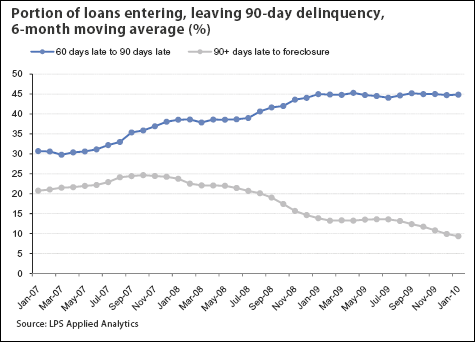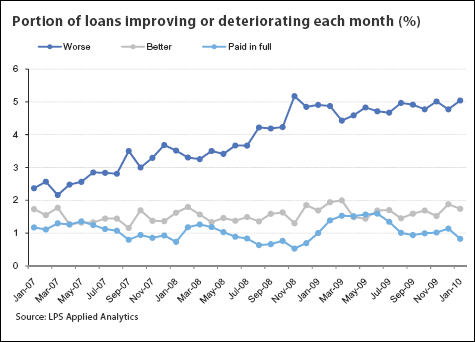Even though recent data releases indicate that foreclosure rates are  slowing, delinquency rates are
slowing, delinquency rates are  declining and home prices are
declining and home prices are  stabilizing, the nation's foreclosure problems are expected to persist for
stabilizing, the nation's foreclosure problems are expected to persist for  years.
years.
A primary reason for the chronic foreclosure problem is a glut of delinquencies and a relative dearth of bank repossessions, a trend also known as the " pig in the python." While industry observers have noticed the
pig in the python." While industry observers have noticed the  trend for months, new data from LPS Applied Analytics show the problem has not just continued but grown.
trend for months, new data from LPS Applied Analytics show the problem has not just continued but grown.
The company slices delinquent mortgages into buckets and then measures the movement of each bucket month to month. In January, 9.34% of all loans at least 90 days late moved into foreclosure based on a six-month moving average. It was the lowest rate on record for the metric, which goes back to 1995. At the other end, loans moved into the 90-day bucket at one of the fastest clips on record, with 44.84% of all 60-day-late mortgages turning 90 days late in January. Before 2008, the metric had never breached 40%.

Weakness in the delinquency numbers is not confined to the 90-day bucket, Steve Berg, managing director of LPS Applied Analytics, told SNL.
"Trying to find something positive in the numbers is darn hard to do," Berg said.
Even the Mortgage Bankers Association's latest national delinquency survey, which offered hope that the market had reached the beginning of the end of the foreclosure crisis, suggested the pig was growing. Though the survey showed that on a seasonally adjusted basis, 30-day delinquencies dropped to 3.31% during the 2009 fourth quarter from 3.57% in the third quarter, the 90-day delinquency bucket grew to 4.62% from 4.41%.
Michael Fratantoni, vice president of single-family research for the industry group, told SNL that government policies have been a big contributor to the growing 90-day-delinquency bucket.
"I think that it's been pretty clear that these efforts to delay the foreclosure process — that's precisely what they're doing: They're delaying; they're not resolving in many cases. And at some point there is going to be an effort to resolve these longer-run delinquencies," Fratantoni said. "We're starting to see that now with Treasury's  program to streamline and encourage short sales. And I expect that's where more of these resolutions are headed in the months and years ahead."
program to streamline and encourage short sales. And I expect that's where more of these resolutions are headed in the months and years ahead."
One of the largest government programs has been the  Home Affordable Modification Program, which encourages servicers to delay the foreclosure process and enter trial loan modifications.
Home Affordable Modification Program, which encourages servicers to delay the foreclosure process and enter trial loan modifications.
Eric Landry, an analyst with Morningstar, also looked to the Obama administration when asked to explain why the glut of delinquencies continues to grow without a proportionate rise in foreclosures. Landry told SNL that the administration's reaction to the foreclosure crisis has differed wildly from the last time delinquencies spiked in the early 1990s.
"The regulators are taking a more lenient approach with the banks," Landry said. "Everybody who analyzes this stuff sort of made their assumptions based upon what happened in 1990 when the regulators went into the banking industry and cleaned them out all at once. Basically they walked in there with a baseball bat and said, 'You're done, you're done, you're done,' and basically auctioned everything off. This time they've gone in there and shored up the capital structures of these institutions to a large degree, especially the big ones, and are saying, 'You need to get rid of this stuff,' and then, sort of with a wink and a nod, 'but don't do it too quickly as to further distort the housing market.'"
Cristian de Ritis, a credit analyst with Moody's Economy.com, told SNL that he and Fratantoni have similar expectations, predicting short sales will increase significantly over the next few months. De Ritis is not the only one; various industry observers have dubbed 2010 "the year of the short sale."
At the same time, something beyond governmental policy appears to be causing the glut of delinquencies to grow. Quite simply, the number of loans that deteriorate each month far outstrips the number of loans that improve, according to LPS data.

Berg, the LPS analyst, agrees that the drop in 30-day delinquencies is a positive sign for a nation struggling with high delinquency rates. But with roll rates still deteriorating and foreclosures stagnant, Berg hesitated to forecast an end to the crisis.
"Trying to predict the peak of the market, or when is foreclosure inventory going to peak, it's anybody's guess because of the elongated foreclosure timelines that are occurring," Berg said. "Foreclosure moratoria, it's things like that that make it a very tough question to answer. … You just can't rely on historical roll rate trends and historical liquidation timelines for foreclosures."


